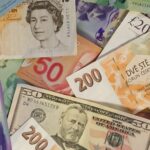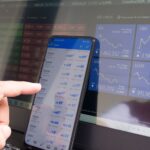Many forex traders make it their lifelong mission to find the best technical analysis indicator or combination of indicators to tell them whether to buy or sell and when to open and close. Too many traders think indicators are the answer to successful trading. New traders studying how to trade are barraged with articles, eBooks, webinars, and videos on how to trade using technical analysis indicators. This belief is amplified by the fact there’s an entire economy around selling custom indicators, each one claiming to be the holy grail. Should you use indicators or not? The Forex industry is rife with scams and scammers; be careful. Educate yourself with as much from reputable sources as you can. Let’s discuss how to trade without indicators.
Can you remember your learning phase and reading about one indicator that’s great for identifying trends? Then another for momentum, another for volatility? Ultimately you’ve got 15 indicators, and your chart looks like a bowl of tie-dye spaghetti.
But wait, do you need indicators to trade forex? The notion of trading forex without indicators may seem controversial. There is a technique called naked forex trading, where users avoid using indicators.
Let’s see if you really can trade forex without indicators.
What is the problem with using indicators?
There is nothing inherently wrong with using indicators. But they can be a trap for self-conscious traders to use more than is necessary. Trading platforms such as MetaTrader 4, cTrader, TradingView, and many others provide dozens of pre-installed indicators and support custom-developed indicators.
The forex market is incredibly dynamic, and opportunities come and go on a dime. Using too many indicators can lead to analysis paralysis. If you wait for too many indicators to line up and validate one another, you’ll probably end up with conflicting signals and delayed confirmations, causing confusion and opportunity loss.
For more advanced traders, they believe that technical analysis becomes a self-fulfilling prophecy. Suppose everyone uses the same indicators, such as banks, hedge funds, market makers, brokers, algo-traders, and many thousands of self-taught traders all use the same technical analysis tool kit. In that case, you make the same moves at the same time as everyone else, and you’ll always be too late.
What is naked forex trading?
Naked forex trading is a method where traders keep their charts completely clear of any technical analysis indicators, such as moving averages, MACD, and Bollinger Bands, all considered lagging indicators. The advantage of this approach is that it lets you focus solely on the current price, which is the most recent piece of information concerning how the market will move. The specific technique used is called price action trading.
What is price action trading?
Price action trading focuses exclusively on the current price and disregards historical prices. The method is used for intraday trading on small timeframes. The smallest time frame on a candlestick chart is 1-minute. Suppose you are trading a Price Action strategy, which means observing data up to 59 seconds old. Most platforms also have a tick chart, showing every price movement as an individual data point.
Price action traders analyze the charts themselves without support from any indicators. They use a combination of candlestick formations, chart patterns, line studies, and volume to understand the market and get price action signals.
Candlestick formations
Price action trading utilizes candlestick formations, such as Doji, Spinning Top, Hammer, Shooting Star, Bearish Engulfing, Bullish Engulfing, and more. For example, a Hammer is found at the bottom of a downtrend. A hammer candlestick generally indicates selling pressure throughout the period, but intense buying pressure drives the price upwards. This candlestick can be red or green, although green hammers indicate a stronger bull signal.
Chart patterns
Price action trading follows chart patterns like Head & Shoulders, Double Top, Double Bottom, Triple Top, Triple Top, Falling Wedge, Rising Wedge, Flag, and others. For example, a Head & Shoulders pattern predicts a bullish-to-bearish reversal. The pattern consists of a prominent peak with a slightly smaller peak on either side, but all fall back to the same support level, otherwise known as the neckline. A breakout into a bearish downtrend will likely occur once the third peak has fallen back to the neckline.
Trend lines
Price action trading uses line studies to plot Support & Resistance zones and trend lines. It’s important to note that these objects are not indicators per se; they’re considered line studies. For example, when the market breaks through a support level, it suggests the price will move to another critical level.
Volume
Price action trading follows volume, which isn’t considered an indicator because it’s a statistic showing the number of ticks or orders in a given period. For example, if the price is not moving, but the volume is high, there is substantial demand on either side of the market.
Naked trading vs. price action trading
The difference between naked trading and price action is murky, and the two terms are often used interchangeably. Price action trading strategies are better documented, whereas naked trading is simply slang for keeping your charts free of clutter.
Can anyone trade without indicators?
Price action trading strategies are only suitable for short-term trading strategies and are especially popular with forex traders because of the vast liquidity and scale of the market. Price action is considered an advanced trading style that relies on experience, intuition, and split-second decision-making. However, practicing trading without indicators on a demo account can help you develop your trading skills whether you adopt a naked trading strategy or not. Like many things, somewhere in the middle may be best for you. Practice makes perfect, so do your indicator organizing to determine what’s best for you.
This post was written with the help of Fiverr. I work with Fiverr freelancers who are experts in different areas; that’s how I can give you such variety. If you want to learn more about the author, check out Winston Thesis. Here is another Forex post by the same author: Five Tips to Increase Your Forex Trading Profit.
Subscribe for more investing posts. Have a lovely day.
Disclaimer
The content on this website is provided for educational and informational purposes only. It is not intended as financial advice or a recommendation to invest in Forex or any other financial market. We do not provide investment, legal, or financial advice, and we are not financial advisors.
Forex Trading is High-Risk: Forex trading carries a high level of risk and may not be suitable for all individuals. It is essential to understand that trading in the foreign exchange market involves substantial risk, and you may lose more than your initial investment. Before engaging in Forex trading, you should carefully consider your financial situation and risk tolerance.
Be Cautious of Scams: The Forex market is known for its potential for scams and fraudulent activities. Be vigilant and exercise caution when exploring opportunities in the Forex market. Always verify the credibility and legitimacy of any service providers, brokers, or trading platforms you may encounter. Do your research and look up any websites you will use for trading with the words scam in your search engine bar. This will help you be able to find examples of scams and make your own opinion.
We are committed to providing educational content to help readers understand the complexities of the Forex market, its risks, and how to protect ourselves from potential scams. However, we are not responsible for any actions taken based on the information provided on this website. It is essential to conduct your research and consult with qualified financial professionals before making any investment decisions.
By using this website, you acknowledge and agree that you are solely responsible for your trading decisions, and you do so at your own risk.
Please consult with a financial advisor or a qualified professional before making any financial decisions. The information on this website is not a substitute for professional advice, and we disclaim any liability for any decisions made based on the content provided here.











